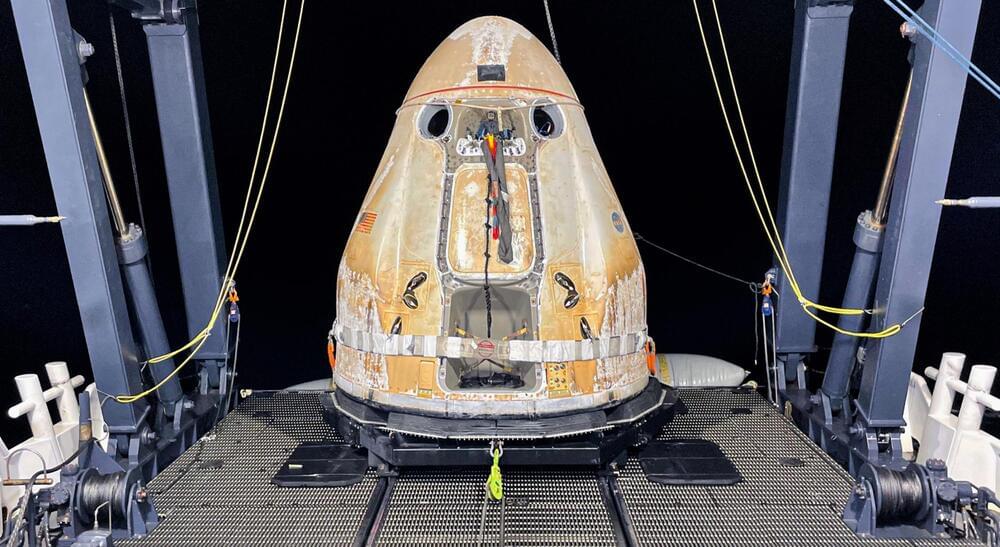The tech giant, Google, has clarified its position on AI-generated content, stating that content created solely for search engine rankings violates their guidelines; however, it is not an issue if created with people in mind.



𝐁𝐫𝐞𝐚𝐤𝐭𝐡𝐫𝐨𝐮𝐠𝐡!
𝐍𝐞𝐮𝐫𝐨𝐬𝐜𝐢𝐞𝐧𝐭𝐢𝐬𝐭𝐬 𝐬𝐨𝐥𝐯𝐞 𝐦𝐲𝐬𝐭𝐞𝐫𝐢𝐞𝐬 𝐚𝐛𝐨𝐮𝐭 𝐥𝐞𝐚𝐝𝐢𝐧𝐠 𝐛𝐢𝐨𝐦𝐚𝐫𝐤𝐞𝐫 𝐟𝐨𝐫 𝐀𝐥𝐳𝐡𝐞𝐢𝐦𝐞𝐫’𝐬
𝙐𝙣𝙞𝙫𝙚𝙧𝙨𝙞𝙩𝙮 𝙤𝙛 𝙑𝙞𝙧𝙜𝙞𝙣𝙞𝙖 𝙣𝙚𝙪𝙧𝙤𝙨𝙘𝙞𝙚𝙣𝙩𝙞𝙨𝙩𝙨 𝙝𝙖𝙫𝙚 𝙧𝙚𝙫𝙚𝙖𝙡𝙚𝙙 𝙝𝙤𝙬 𝙖 𝙩𝙤𝙭𝙞𝙘 𝙛𝙤𝙧𝙢 𝙤𝙛 𝙩𝙖𝙪 𝙥𝙧𝙤𝙩𝙚𝙞𝙣, 𝙣𝙤𝙩𝙤𝙧𝙞𝙤𝙪𝙨 𝙛𝙤𝙧 𝙛𝙤𝙧𝙢𝙞𝙣𝙜 𝙩𝙖𝙣𝙜𝙡𝙚𝙨 𝙞𝙣 𝙩𝙝𝙚 𝙗𝙧𝙖𝙞𝙣𝙨 𝙤𝙛 𝙥𝙚𝙤𝙥𝙡𝙚 𝙬𝙞𝙩𝙝 𝘼𝙡𝙯𝙝𝙚𝙞𝙢𝙚𝙧’𝙨 𝙙𝙞𝙨𝙚𝙖𝙨𝙚 𝙖𝙣𝙙 𝙨𝙚𝙫𝙚𝙧𝙖𝙡 𝙤𝙩𝙝𝙚𝙧 𝙣𝙚𝙪𝙧𝙤𝙙𝙚𝙜𝙚𝙣𝙚𝙧𝙖𝙩𝙞𝙫𝙚 𝙙𝙞𝙨𝙤𝙧𝙙𝙚𝙧𝙨, 𝙨𝙥𝙧𝙚𝙖𝙙𝙨 𝙩𝙝𝙧𝙤𝙪𝙜𝙝 𝙩𝙝𝙚 𝙗𝙧𝙖𝙞𝙣 𝙖𝙨 𝙩𝙝𝙚 𝙙𝙞𝙨𝙚𝙖𝙨𝙚 𝙥𝙧𝙤𝙜𝙧𝙚𝙨𝙨𝙚𝙨.
The new discovery advances the battle against the disease, which strikes 1 in 9 people over age 65.

Japan says it will release more than a million tonnes of water into the sea from the destroyed Fukushima nuclear power plant this year.
After treatment the levels of most radioactive particles meet the national standard, the operator said.
The International Atomic Energy Agency (IAEA) says the proposal is safe, but neighbouring countries have voiced concern.
The 2011 Fukushima disaster was the worst nuclear accident since Chernobyl.
Click the link to see if its a bad idea, Godzilla sure doesnt.
Tokyo plans to release a million tonnes of water contaminated by the destroyed Fukushima plant.
Researchers have developed a way to use laser light to pull a macroscopic object. Although microscopic optical tractor beams have been demonstrated before, this is one of the first times that laser pulling has been used on larger objects.
Light contains both energy and momentum that can be used for various types of optical manipulation such as levitation and rotation. Optical tweezers, for example, are commonly used scientific instruments that use laser light to hold and manipulate tiny objects such as atoms or cells. For the last ten years, scientists have been working on a new type of optical manipulation: using laser light to create an optical tractor beam that could pull objects.
“In previous studies, the light pulling force was too small to pull a macroscopical object,” said research team member Lei Wang from QingDao University of Science and Technology in China. “With our new approach, the light pulling force has a much larger amplitude. In fact, it is more than three orders of magnitudes larger than the light pressure used to drive a solar sail, which uses the momentum of photons to exert a small pushing force.”

Twitter has added cashtag support for Shiba Inu. The recently launched initiative will allow SHIB, enthusiasts to keep track of these crypto assets’ prices along with BTC, ETH, and Doge. To use the service, users are required to search for the symbol of any of the supported digital currencies with the dollar sign ($) in front of it. For instance, Twitter users can check the price of Shiba Inu by typing $SHIB in the search bar. The search result will include the pricing graphs of Shiba Inu alongside a clickable link that will take the user directly to Robinhood. Crypto enthusiasts can quickly create an account on Robinhood to purchase digital currency.
To me a Twitter crypto currency used for Twitter transactions makes sense, as the, volume of transactions would add value to those who buy it early as an investment. Twitter could also prevent Some BankFraud-Fried incidents.

A SpaceX Cargo Dragon 2 spacecraft has safely returned to Earth after delivering several tons of NASA supplies to the International Space Station (ISS).
A little over six weeks after Falcon 9 launched SpaceX’s 26th Commercial Resupply Services 2 (CRS2) mission for NASA, Dragon departed the ISS on January 9th. Efficiently lowering its orbit with several small Draco thrusters took about 36 hours, and reusable Dragon 2 capsule C211 eventually slowed to the point that it began impacting Earth’s atmosphere. Using its ablative heat shield like a brake pad, Dragon slowed from a velocity of 7.5 kilometers per second (16,800 mph) to about 155 meters per second (~350 mph) before beginning parachute deployment.
At 5:19 am on January 11th, the Dragon capsule gently splashed down off the coast of Tampa, Florida, and was quickly secured by a SpaceX recovery ship. Once onboard, the capsule was opened up, and cargo fresh from orbit was loaded onto a helicopter as quickly as possible. That system – primarily created to rapidly transport astronauts back to NASA medical facilities – also means that scientists can get access to their recovered ISS experiments just a handful of hours after Cargo Dragon splashes down.
This might be important. It might not be over for metformin just yet though as a mice study showed that rapamycin combined with metformin removed each other’s side effects.
If you are a non-diabetic who takes metformin for longevity, I highly recommend you stop immediately. Hear me out, and at the end of the video I’ll share what to do instead.
My full supplement stack: https://drstanfield.com/my-supplements/
Supplements I source from Amazon: http://amzn.to/3o2ULOV
✨10% Discount Code: BRAD ✨
• DoNotAge.org: https://donotage.org/products/
• Renue By Science: https://renuebyscience.com/?rfsn=5206061.b626e7&coupon-code=brad.
• ProHealth: https://www.prohealthlongevity.com/collections/best-sellers.
✨10% Discount Code: BRAD ✨
Donate towards my Rapamycin & Exercise clinical study: https://bit.ly/3QwugRx.
https://www.youtube.com/watch?v=UI-h9mfdiN0
@houseoflongevity Full Longevity Escape Velocity video: https://www.youtube.com/watch?v=UI-h9mfdiN0&t=10s Rich Roll Podcast interview:
ChatGPT, OpenAI’s newest model is a GPT-3 variant that has been fine-tuned using Reinforcement Learning from Human Feedback, and it is taking the world by storm!
Sponsor: Weights & Biases.
https://wandb.me/yannic.
OUTLINE:
0:00 — Intro.
0:40 — Sponsor: Weights & Biases.
3:20 — ChatGPT: How does it work?
5:20 — Reinforcement Learning from Human Feedback.
7:10 — ChatGPT Origins: The GPT-3.5 Series.
8:20 — OpenAI’s strategy: Iterative Refinement.
9:10 — ChatGPT’s amazing capabilities.
14:10 — Internals: What we know so far.
16:10 — Building a virtual machine in ChatGPT’s imagination (insane)
20:15 — Jailbreaks: Circumventing the safety mechanisms.
29:25 — How OpenAI sees the future.
References:
https://openai.com/blog/chatgpt/
https://openai.com/blog/language-model-safety-and-misuse/
https://beta.openai.com/docs/model-index-for-researchers.
https://scale.com/blog/gpt-3-davinci-003-comparison#Conclusion.
New post: What the delay in launching text-davinci-003 tells us about RLHF via PPO and instruction tuning more generally. https://t.co/Q3FUekFERk
— John McDonnell (@johnvmcdonnell) December 2, 2022
https://twitter.com/blennon_/status/1597374826305318912
Ran one of our essay questions through @OpenAI’s new chatbot. Essays are dead.
Back to hand-written exams I guess. Sigh. pic.twitter.com/nzzhRwGp05
— Tim Kietzmann (@TimKietzmann) December 1, 2022

📧 Imagine you’re in a hurry and need to type formal email quickly. With VoiceGPT, you can instantly summon the voice prompt with a single click and receive the answer spoken back to you, and have it directly copied to your clipboard to paste it into email. No need to type out your question or even look at your screen. Or imagine you’re in a meeting and someone writes some important information on a whiteboard. With VoiceGPT’s OCR technology, you can take a photo of the whiteboard, extract the text and have ChatGPT process it.